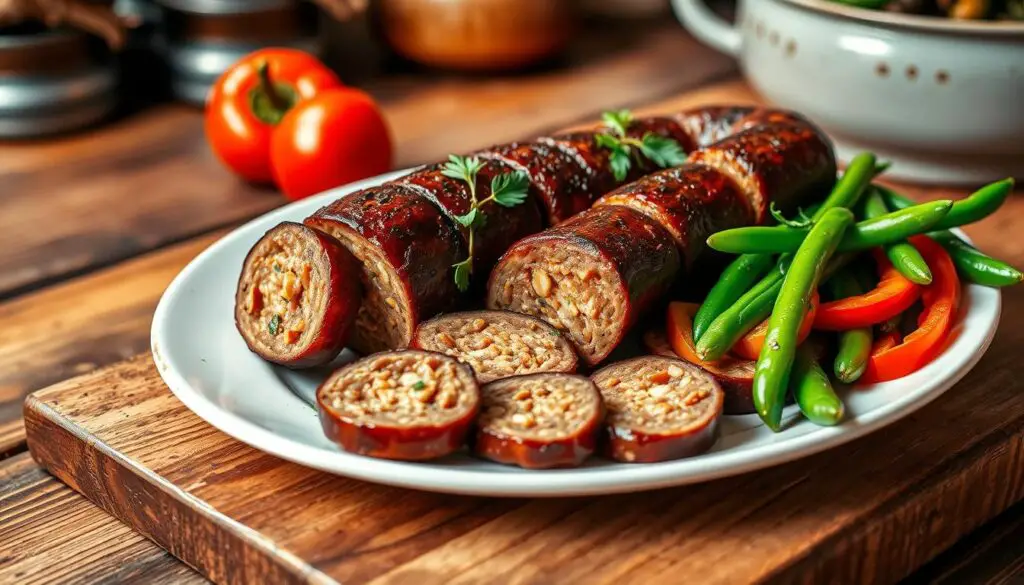Spanish chorizo is a flavorful and versatile sausage that’s key in paella, a classic Spanish rice dish. But, if you can’t find Spanish chorizo or want to try something different, there are great substitutes. This article will look at the top 5 substitutes for Spanish chorizo in paella. We’ll cover their key features, how much to use, and recipe ideas to make your cooking delicious.
- What is Spanish Chorizo?
- The Importance of Spanish Chorizo in Paella
- Substitute for Spanish Chorizo in Paella
- Andouillette Sausage: A French Flair
- Salami: A Classic Italian Choice
- Kielbasa Sausage: A Polish Perspective
- Ground Pork and Smoked Paprika: A DIY Option
- Chickpeas and Smoked Paprika: A Vegetarian Solution
- Flavor Combinations and Recipe Ideas
- Conclusion
What is Spanish Chorizo?
Spanish chorizo is a cured pork sausage with a smoky paprika flavor. It can be mild or spicy, and its texture varies. It’s meant to be sliced and cooked, adding a smoky taste to dishes.
Understanding the Essence of Spanish Chorizo
The secret to Spanish chorizo’s taste is its seasoning. It’s made from ground pork mixed with smoked paprika, garlic, and spices. This mix gives it a savory, smoky, and sometimes spicy flavor.
Cured vs. Fresh: Exploring the Different Types
Spanish chorizo comes in two forms: cured and fresh. The cured version is dry and aged, like a salami. Fresh chorizo is raw and needs to be cooked. Both are used in paella, but cured is more traditional.
“Spanish chorizo is an essential ingredient in many classic Spanish dishes, adding a distinctive smoky and spicy flavor to the overall dish.”
Spanish chorizo, whether cured or fresh, is great in many dishes. It adds a unique flavor and texture to paella, stews, and more. Its versatility makes it a favorite in Spanish cooking.
The Importance of Spanish Chorizo in Paella
Spanish chorizo is key in paella, the famous Spanish rice dish. It brings smoky, paprika flavors that add depth and richness. Without it, paella’s true taste is hard to get.
Paella comes from Spanish poor food. But, Spanish chorizo has caused controversy. Some say it’s not traditional, leading to diplomatic issues.
Many see Spanish food as better than others. This view affects paella, with some saying chorizo changes its taste. Yet, chorizo’s smoky flavor is loved by many.
Paella’s regional recipes are also a big deal. For example, Valencian paella includes rabbit. Chorizo in paella sparks debate. It’s a big part of Spanish culture.
| Key Paella Ingredients | Importance |
|---|---|
| Spanish Chorizo | Provides depth, richness, and texture to the dish |
| Short Grain Rice (e.g., Bomba) | Ideal for paella’s even cooking and absorption of flavors |
| Spanish Saffron | A key ingredient that imparts the distinctive yellow color and aroma |
| Sofrito | A sautéed mixture of onions, tomatoes, garlic, and smoked paprika that forms the base |
| Socarrat | The crispy, caramelized rice at the bottom of the pan, a beloved aspect of paella |
“Mastering paella may take at least half a dozen tries according to the text.”
The debate over Spanish chorizo in paella shows the deep traditions of Spanish food. While some argue it’s not traditional, its flavor is undeniable. Chorizo in paella shows the evolving nature of Spanish food.
Substitute for Spanish Chorizo in Paella
Spanish chorizo is key in traditional paella. But, you can use other sausages to get a similar taste. Mexican chorizo and Linguica sausage are great options.
Mexican Chorizo: A Spicy Alternative
Mexican chorizo is a spicy sausage made from ground pork. It’s seasoned with chili peppers and spices. It’s crumbly and adds a bold, spicy flavor to paella, just like Spanish chorizo.
The main difference is that Mexican chorizo is fresh and uncooked. Spanish chorizo is cured.
Linguica: A Portuguese Twist
Linguica is a Portuguese sausage similar to Spanish chorizo. It’s smoky and tangy, seasoned with garlic and paprika. Its firm texture is perfect for paella.
While not identical, Linguica brings a unique Portuguese taste to paella. It’s a great choice for adding variety to your dish.
When using Mexican chorizo or Linguica, adjust cooking times and methods. Their textures and cooking needs differ from Spanish chorizo. Try these alternatives to find the best fit for your paella.
“Paella was traditionally cooked using foods like rice, eels, wild duck, wild rabbit, snails, and frogs’ legs, reflecting the region’s rich wildlife.”
Andouillette Sausage: A French Flair
Adding andouillette sausage to your paella brings a unique flavor. This French delicacy has a rich, savory taste. It’s different from Spanish chorizo because it includes pork offal.
Andouillette’s flavor is earthy and umami. It pairs well with paella’s vibrant aromas and textures. This combination makes for a memorable meal.
| Ingredient | Quantity |
|---|---|
| Olive oil | 2 Tbsp |
| Andouillette sausage, sliced | 1 lb |
| Arborio rice | 2 cups |
| Vegetable broth | 4 cups |
| Saffron threads | 1 tsp |
| Shrimp, peeled and deveined | 1 lb |
| Peas | 1 cup |
To add andouillette sausage to your paella, slice it and sauté it in olive oil. Then, mix it with Arborio rice, saffron, and seafood. The unique taste of andouillette will make your dish special.

“Andouillette sausage adds a distinctive offal flavor that can elevate your paella to new heights of savory deliciousness.”
Salami: A Classic Italian Choice
Salami is a great Italian sausage to use instead of Spanish chorizo in paella. It has a bold, savory taste and a chewy texture. These qualities add depth to the dish.
Salami is different from Spanish chorizo because it’s cured, not smoked. It’s made from pork and beef. You can find many types, like Genoa salami or spicy Calabrese.
| Characteristic | Spanish Chorizo | Salami |
|---|---|---|
| Meat Composition | Pork | Pork and Beef |
| Flavor Profile | Smoky and Spicy | Bold and Savory |
| Texture | Firm and Moist | Chewy and Dry |
| Processing Method | Smoked and Seasoned | Cured and Fermented |
Using salami instead of Spanish chorizo changes the flavor. But, salami’s bold taste can enhance the dish. Try different salamis to match your paella’s taste.
Choosing salami or another substitute is key to a great paella. With some trial and error, you can make a tasty dish that blends Italian and Spanish flavors.
Kielbasa Sausage: A Polish Perspective
Kielbasa, a Polish sausage, is a great substitute for Spanish chorizo in paella. It has a smoky and mildly spiced taste. This can add depth to your paella, even if it’s not as spicy as chorizo.
Cooking Tips for Kielbasa in Paella
To get the best out of kielbasa in paella, follow these steps:
- Cook the kielbasa well before adding it to the paella. This makes sure it’s safe to eat and brings out the flavors.
- Cut the kielbasa into small pieces or crumble it. This helps it spread evenly in the dish.
- Try searing or browning the kielbasa first. This boosts its smoky taste and adds to the dish’s complexity.
By doing these simple things, you can make kielbasa a key part of your paella. It will give you a unique and tasty dish.

Kielbasa’s flexibility lets you try different cooking ways and flavors. This makes your paella truly special.
Ground Pork and Smoked Paprika: A DIY Option
If you can’t find sausage substitutes, make your own “chorizo” with ground pork and smoked paprika. This way, you can adjust the spice and flavor to match Spanish chorizo in your paella.
To make your own chorizo, brown 1 pound of ground pork in a skillet over medium-high heat. After it’s cooked, add 2 teaspoons of smoked paprika, 1 teaspoon of garlic powder, 1/2 teaspoon of crushed red pepper flakes, and salt. The smoky and spicy flavors will give your paella a chorizo-like taste.
This homemade pork mix can replace Spanish chorizo in your paella. The best part is, you can change the spice level to your liking. Start with the suggested seasonings and adjust them to get the flavor just right.
The secret to using ground pork and smoked paprika as a chorizo substitute is to capture its smoky, spicy, and savory essence. By controlling the seasoning, you can make a chorizo-like component that fits perfectly in your paella.
Chickpeas and Smoked Paprika: A Vegetarian Solution
Chickpeas seasoned with smoked paprika make a great vegetarian or pork-free substitute for Spanish chorizo in paella. They offer a similar texture and a smoky flavor, making the dish delicious without meat.
Legumes, like chickpeas, are good for the environment. They need less fertilizer, pesticides, and water compared to other foods. The recipe uses about 240g of cooked chickpeas and suggests 200g of cooking chorizo or a plant-based alternative.
The recipe includes 2 teaspoons of smoked paprika for extra flavor. You can also add 2 eggs for more customization. To prepare, fry the chorizo until it’s golden, then sauté red onion, rainbow chard, and tomatoes. Finish by combining them with the chickpeas.
The dish is topped with parsley and garnished with diced fried chorizo. Crushed chickpeas are added to improve the texture and flavor. This makes a tasty vegetarian substitute for Spanish chorizo in paella.
This chickpea and chorizo brunch is both tasty and eco-friendly. It highlights the versatility of chickpeas and legumes. It’s a great choice for those looking for a meat-free or plant-based option.
Flavor Combinations and Recipe Ideas
Looking for a Spanish chorizo substitute in your paella? The options are vast. Spanish chorizo goes well with broccoli, kale, peppers, chicken, seafood, and chickpeas in paella. Try out various flavor mixes and recipes to find the ideal match for your taste and diet.
For a twist on traditional paella, use Mexican chorizo instead. Its spicy taste adds a fun kick. Or, try linguica, a Portuguese sausage, for a unique flavor.
Want a French touch? Use andouillette sausage to bring Spanish chorizo’s essence to your paella. This sausage gives your dish a special taste.
- Try salami for an Italian twist, adding a smoky flavor to your paella.
- For a Polish flavor, use kielbasa sausage and adjust the seasonings to get the right taste.
- For a vegetarian option, mix chickpeas and smoked paprika to mimic Spanish chorizo’s taste and texture.
Choosing the right substitute is all about experimenting. Find the perfect mix of ingredients that you love. With a bit of creativity, you can make a paella that’s just as tasty as the original.
“The beauty of paella is in its flexibility. By exploring different ingredient substitutions, you can create a dish that truly reflects your personal preferences and dietary needs.”
Conclusion
Looking for a Spanish chorizo substitute in paella? You have many tasty options. Try Mexican chorizo, linguica, andouillette sausage, salami, or kielbasa. Each brings its own flavor and cooking possibilities.
These alternatives let you create delicious paella variations. You can enjoy the true taste of Spanish cuisine, even without traditional chorizo. It’s all about understanding and using these substitutes well.
Want to try something bold like Mexican chorizo or smoky linguica? Or maybe you prefer the subtle taste of andouillette, salami, or kielbasa? The choices are endless. By mixing these into your paella, you can make dishes that truly capture Spanish flavors.
Paella is all about being flexible and open to new tastes. Without Spanish chorizo, you can explore new flavors. A bit of creativity and experimentation can lead to amazing paella dishes that will wow your guests.









